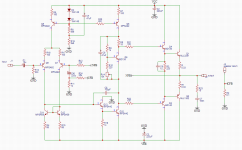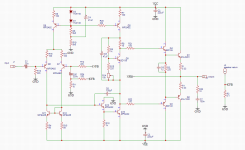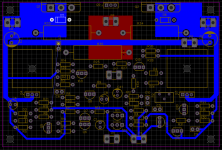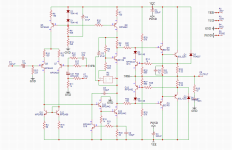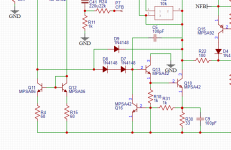Hi,
I am starting a project building a solid-state guitar amplifier similar to the Vox AC30. I realise that this will not be a proper 'clone' or 'simulation', I'm just hoping to capture some of the flavour of the amp in an all solid-state design.
My overall rough plan is:
- BJT class AB power amplifier with mixed mode feedback, aiming to approximate the damping factor of the real AC30. I will be using +-30V rails to achieve a few under 50W output.
- Celestion AlNiCo Gold 50W speaker, similar to the bluebacks used in the real amp, but higher power, enabling me to use only one speaker.
- Op-amp based preamp, modelled roughly around the layout of the AC30 preamp, with both normal and top-boost channels, master volume, tone-cut control and AC30 tone-stack on the top-boost channel (with scaled values).
- Spring reverb
- speaker DC protection and turn-on delay using MOSFET relay.
I realise that this is a rather complex project and I expect it to take a while. Progress may be quite slow as I work full-time but I'm finding free moments to work on it.
I am basing by design around what i have read in Audio Power Amplifier Design by Douglas Self and Solid-State Guitar Amplifiers by Teemu Kytala (I enjoyed Teemu's book so much I had someone print and handback bind it) as well as various articles by Rod Elliott.
So far, I have built the cabinet (rough and unfinished) to house the speaker for testing. I have also put together a rough design of the power amp (attached) which I have breadboarded and tested. With just a single TL071 as a preamp, the amplifier already sounds good to me. I did spend some time playing with the feedback resistor values and it now has a nice sound with deep bass and good highs.
The power amp is still incomplete and I am intending to add V-I limiting and VAS current limiting. I imagine there are also other aspects of the circuit that I need to fine-tune. I intend for the amplifier to be reliable in live situations as well as good-sounding.
Anyway, I imagine I'm going to encounter a lot of problems along the way but I hope that some may find the project interesting too. I am very far removed from an expert on building amplifiers so I will greatly appreciate all the suggestions, criticisms and advice that anyone has. I just thought I'd introduce it here before proceeding further.
Thanks,
James
I am starting a project building a solid-state guitar amplifier similar to the Vox AC30. I realise that this will not be a proper 'clone' or 'simulation', I'm just hoping to capture some of the flavour of the amp in an all solid-state design.
My overall rough plan is:
- BJT class AB power amplifier with mixed mode feedback, aiming to approximate the damping factor of the real AC30. I will be using +-30V rails to achieve a few under 50W output.
- Celestion AlNiCo Gold 50W speaker, similar to the bluebacks used in the real amp, but higher power, enabling me to use only one speaker.
- Op-amp based preamp, modelled roughly around the layout of the AC30 preamp, with both normal and top-boost channels, master volume, tone-cut control and AC30 tone-stack on the top-boost channel (with scaled values).
- Spring reverb
- speaker DC protection and turn-on delay using MOSFET relay.
I realise that this is a rather complex project and I expect it to take a while. Progress may be quite slow as I work full-time but I'm finding free moments to work on it.
I am basing by design around what i have read in Audio Power Amplifier Design by Douglas Self and Solid-State Guitar Amplifiers by Teemu Kytala (I enjoyed Teemu's book so much I had someone print and handback bind it) as well as various articles by Rod Elliott.
So far, I have built the cabinet (rough and unfinished) to house the speaker for testing. I have also put together a rough design of the power amp (attached) which I have breadboarded and tested. With just a single TL071 as a preamp, the amplifier already sounds good to me. I did spend some time playing with the feedback resistor values and it now has a nice sound with deep bass and good highs.
The power amp is still incomplete and I am intending to add V-I limiting and VAS current limiting. I imagine there are also other aspects of the circuit that I need to fine-tune. I intend for the amplifier to be reliable in live situations as well as good-sounding.
Anyway, I imagine I'm going to encounter a lot of problems along the way but I hope that some may find the project interesting too. I am very far removed from an expert on building amplifiers so I will greatly appreciate all the suggestions, criticisms and advice that anyone has. I just thought I'd introduce it here before proceeding further.
Thanks,
James
Attachments
I haven't managed to find many complete DIY solid state guitar amp projects. Rod Elliott has a 100W head design and I've seen an excellent solid state guitar combo project, where the preamp was modelled around an Ampeg solid-state amp. Apart from that, they seem to be very rare.
There are a number of AC30 sim pedals that I've looked at. Run off groove has a couple that are discrete FET based and there was an op-amp based one on Rod Elliott's site that has now been removed. Other examples can be found and usually they attempt to follow the same circuit layout as the valve amp, just implemented in solid state.
Session guitar amps (Sessionette 75, Blues Baby) follow a similar idea, only they are based around Fender amplifiers.
I haven't been able to find an example of someone building a complete guitar combo based around the AC30. Plenty of valve builds but no solid state attempts.
Thanks,
James
There are a number of AC30 sim pedals that I've looked at. Run off groove has a couple that are discrete FET based and there was an op-amp based one on Rod Elliott's site that has now been removed. Other examples can be found and usually they attempt to follow the same circuit layout as the valve amp, just implemented in solid state.
Session guitar amps (Sessionette 75, Blues Baby) follow a similar idea, only they are based around Fender amplifiers.
I haven't been able to find an example of someone building a complete guitar combo based around the AC30. Plenty of valve builds but no solid state attempts.
Thanks,
James
Vox actually produced some decent solid state amps early on. A lot of people like the Pathfinder series, and there's some schems available if you search for Vox Midas 50 series which was a late 60's design. It's on korguk.com, and you will see 3 sections on the preamp for the instrument channel. Input preamp, mixer section and limiter driver. You may want to explore some of those elements for your design. The preamp is likely cleanish with the EQ stack then going through mixer and then onto limiter driver. You may be able to just sub your op amp into the front end with the tonestack, an apply the limiter driver..
I've had a look over the AC30SS schematic from the early 70s. it looks like they've followed the same overall design as the valve AC30, just using op-amps in the preamp and a quasi-complementary output stage. Their implementation of the cut control in solid state is useful to see.
Other schematics I've been studying are for two of my favourite guitar amps: the Sessionette 75 and the HH IC100.
Other schematics I've been studying are for two of my favourite guitar amps: the Sessionette 75 and the HH IC100.
I think the fact that you are choosing to use a very good and proper speaker is going to make a big difference to the sound quality. Stewart Ward (Award-Session amps) said in an interview that a problem with a lot of commercial solid state guitar amps is the fact they cheap out on speaker selection. JM Fahey has stated that many times on this forum as well, and he has LOTS of experience building and selling solid state guitar amps.
I assume you are not the first to try this out. Did you do some internet research on this topic?
He's read Rod Elliot. What more do you need to know?
Oh. This.
At least he's found runoffgroove. And hopefully the britannia
But the comment I hear most often about the AC30 is that it's too bloody loud (for home use). It'll be interesting to see how James gets on: usually you can't clip an SS amp like a valve one (they usually sound like crap or blow up) - the design above looks completely conventional.
Gnobuddy reported that he did get a decent sounding SS set up a year or two back. And there is another thread hereabouts looking at IIRC a Vox valve reactor SS output stage which is a current amplifier rather than a voltage amplifier. (So James, fire up your favourite search engine)
Last edited:
I think the fact that you are choosing to use a very good and proper speaker is going to make a big difference to the sound quality. Stewart Ward (Award-Session amps) said in an interview that a problem with a lot of commercial solid state guitar amps is the fact they cheap out on speaker selection. JM Fahey has stated that many times on this forum as well, and he has LOTS of experience building and selling solid state guitar amps.
Yes, I think this is what sets Stewart's amps apart from most competitors, he puts proper speakers in them. His amps don't contain any complicated modelling or emulation, they're just built well with high-quality parts. I think when a lot of people think of 'solid state guitar amps', they're actually thinking of 'practice amps'. I've met numerous people whose opinions of solid-state guitar amps are based around the 10W Marshall amp with a 6" speaker that they got with their first guitar.
Anyway, what I definitely do not want to do is get involved in any 'valves vs transistors' debates!
He's read Rod Elliot. What more do you need to know?
I understand Rod Elliot splits opinion, presumably in this case with his tendency to be dismissive of valve circuits. I've always found his site to be extremely useful though. At any rate, I only mentioned him as one source of information I've used, i'm not taking his word as gospel on building amplifiers.
He's read Rod Elliot. What more do you need to know?
At least he's found runoffgroove. And hopefully the britannia
But the comment I hear most often about the AC30 is that it's too bloody loud (for home use). It'll be interesting to see how James gets on: usually you can't clip an SS amp like a valve one (they usually sound like crap or blow up) - the design above looks completely conventional.
Gnobuddy reported that he did get a decent sounding SS set up a year or two back. And there is another thread hereabouts looking at IIRC a Vox valve reactor SS output stage which is a current amplifier rather than a voltage amplifier. (So James, fire up your favourite search engine)
The Britannia is indeed the runoffgroove circuit I've looked at, along with an earlier incarnation, the name of which I can't remember. it appears to be very close in design to the real AC30 circuit.
I'm not intending to clip the power amplifier itself. It is, as you say, a conventional design with some current feedback. The only aspect of 'emulation' in the power amp is the aim for a high output impedance to approximate the AC30s damping factor. I'm going to do any clipping in the preamp section and limit the input to the power amp to prevent it from clipping.
I'll look up the threads you mention. There is also a good writeup of the valve reactor in Teemu's book.
Thanks,
James
Agreed. I still have a Traynor Bloc 100W combo which is solid state, from the 80s and still running strong. Great sounding reverb on it, and it keeps up fine. The overdrive is not bad, but you can get a lot of mileage from running various preamps into it's power section through the return effects loop.His amps don't contain any complicated modelling or emulation, they're just built well with high-quality parts.
Good start, and excellent speaker choice, which is essential.
Many forget that in the late 60´s , early 70´s A TON of great performers (say, Creedence Clearwater Revival, Focus, Tina Turner, The Jacksons, The Doors, King´s X and MANY more) used SS amplifiers.
Certainly not because they could not afford tube amps!!!!!
BUT they used the top of the line ones, which were loaded with, guess it: JBL, Altec Lansing, Electrovoice, big and expensive speakers!!!
CCR´s Kustom loaded with JBL:

Doors: Acoustic heads on mountain of Altec speakers

Sessionette used one of the best Celestions or in this case, a Goodmans Audiom 12P
 .
.
Even humble 40 battery powered Electro Harmonix Freedom Amp sported a tasty Celestion Greenback !!!

this is the "battery less" version, guess buying 40 Duracells a week was sort of expensive maintenance.
Many forget that in the late 60´s , early 70´s A TON of great performers (say, Creedence Clearwater Revival, Focus, Tina Turner, The Jacksons, The Doors, King´s X and MANY more) used SS amplifiers.
Certainly not because they could not afford tube amps!!!!!
BUT they used the top of the line ones, which were loaded with, guess it: JBL, Altec Lansing, Electrovoice, big and expensive speakers!!!
CCR´s Kustom loaded with JBL:

Doors: Acoustic heads on mountain of Altec speakers

Sessionette used one of the best Celestions or in this case, a Goodmans Audiom 12P
Even humble 40 battery powered Electro Harmonix Freedom Amp sported a tasty Celestion Greenback !!!

this is the "battery less" version, guess buying 40 Duracells a week was sort of expensive maintenance.
Some good pictures there JM, thanks! The speaker in my Sessionette is a G12H-100, as you say, a top Celestion.
I've done some more work on the power amp and have started designing a PCB. So far, I've only routed the power and ground. The current sense resistor will be mounted separately by the speaker output jack and the feedback returned to the connector in the middle of the board. Please let me know what you think, I'm sure there are lots of improvements to be made!
Thanks,
James
I've done some more work on the power amp and have started designing a PCB. So far, I've only routed the power and ground. The current sense resistor will be mounted separately by the speaker output jack and the feedback returned to the connector in the middle of the board. Please let me know what you think, I'm sure there are lots of improvements to be made!
Thanks,
James
Attachments
Sounds like a good plan.Y
I'm not intending to clip the power amplifier itself. It is, as you say, a conventional design with some current feedback. The only aspect of 'emulation' in the power amp is the aim for a high output impedance to approximate the AC30s damping factor. I'm going to do any clipping in the preamp section and limit the input to the power amp to prevent it from clipping.
As well as assymetrical, staged clipping, which is the basis of a sweet sound, I've also spent a little time playing with power rail sag and IMD (the RoG Ruby has it in spades - I'm still pulling apart which bits are which with battery vs mains games)
I'm having a little look at bias shift in SS circuits at the moment - lead onto it by one of the longer analyses of the Dallas Rangemaster (if I find the URL i'll post it)
On or two of the RoG circuits use this too (e.g. Thunderbird)
but I'm only just starting down this rabbit hole.
Which reminds me that cutting much of the bass & midbass prior to clipping (& then removing everything over 3KHz) seems to be part of the usual mix.
All games you can play with EQ on pedals (jst don't clip the EQ pedal)
Teemu is a new one on me - I've already put that on my to-do list. ThanksI'll look up the threads you mention. There is also a good writeup of the valve reactor in Teemu's book.
That's a solid scheme. Be sure to dimension voltage swing headroom of the power amp high enough: with clipped input signals current feedback will boost the rising edge of the waveform a lot so input signal's peak voltage times nominal power amp's closed loop gain is much less voltage than what the power amp is actually putting out. Or trying to.I'm not intending to clip the power amplifier itself. It is, as you say, a conventional design with some current feedback. The only aspect of 'emulation' in the power amp is the aim for a high output impedance to approximate the AC30s damping factor. I'm going to do any clipping in the preamp section and limit the input to the power amp to prevent it from clipping.
Many current feedback amps that rely on preamp-based limiting actually still clip when you feed them high enough clipped signal.
Peavey uses a "60W" circuit for 30W output in their TransTube amps, Quilter a 400W amp for 100W output, just in order to reproduce the CFB transients involved. Power supply naturally doesn't have to continuously sustain that, it's enough if it can just provide sufficient voltage to produce that short transient.
Last edited:
Sounds like a good plan.
As well as assymetrical, staged clipping, which is the basis of a sweet sound, I've also spent a little time playing with power rail sag and IMD (the RoG Ruby has it in spades - I'm still pulling apart which bits are which with battery vs mains games)
I'm having a little look at bias shift in SS circuits at the moment - lead onto it by one of the longer analyses of the Dallas Rangemaster (if I find the URL i'll post it)
On or two of the RoG circuits use this too (e.g. Thunderbird)
but I'm only just starting down this rabbit hole.
Which reminds me that cutting much of the bass & midbass prior to clipping (& then removing everything over 3KHz) seems to be part of the usual mix.
All games you can play with EQ on pedals (jst don't clip the EQ pedal)
Teemu is a new one on me - I've already put that on my to-do list. Thanks
The preamp design, multistage clipping etc. is what I'm looking forward to doing. Hopefully I can ge the power amp sorted reasonably soon so I can start on the preamp. Limiting the bandwidth pre clipping is something I've seen in a lot of schematics. In a single channel amplifier, that bandwidth limiting would be applied to the clean sound too. Perhaps this isn't a problem, we'll see!
That's a solid scheme. Be sure to dimension voltage swing headroom of the power amp high enough: with clipped input signals current feedback will boost the rising edge of the waveform a lot so input signal's peak voltage times nominal power amp's closed loop gain is much less voltage than what the power amp is actually putting out. Or trying to.
Many current feedback amps that rely on preamp-based limiting actually still clip when you feed them high enough clipped signal.
This has been something I've been wondering about, how to successfully limit the input signal of a current feedback amplifier. With normal voltage drive, it seems simple, just clamp the input signal at just under the maximum output swing divided by the power amp gain. The fact that the gain changes with load seems to pose a problem! What scheme do you propose?
Thanks,
James
There's really no way around it (at least that I would be aware of)): the power amp rail voltage must be high enough to reproduce the signal voltage swings even at the highest gain conditions. Otherwise the power amp will clip.
As said, the power amp simply must be dimensioned to be able to produce more power than you expect as average continuous. (Even more so because a lot of power will be sacrificed for clean reproduction of the signal part "soft clipped" by the preamp-based limiter).
You want 30W clean, soft clipping and low damping factor (like AC30)? ... expect you really need much more than a 30W amp to produce the non-linearities and effects of low damping. (Tube amps mostly have such inefficiency built-in).
Anyway...
For transient reproduction you don't of course need an amp that can continuously sustain all that output power. So yes, it will be easier for the power supply part and thermal load. You also will not be very cautious of transient clipping, it isn't all that audible, and happening at higher frequencies mostly the tone just becomes a bit "darker" (as higher frequencies are compressed by clipping). What I advise is that - despite preamp-based limiting - design the power amp to handle clipping gracefully. Hard clipping isn't bad (or even bad sounding) but make sure the amp doesn't "rail stick" or oscillate simultaneously when overdriven. (e.g. employ Baker clamps or such). Also, you won't likely be cranking the amp "on ten" all the time so clipping at extremes of power is much less of an issue in practice.
As said, the power amp simply must be dimensioned to be able to produce more power than you expect as average continuous. (Even more so because a lot of power will be sacrificed for clean reproduction of the signal part "soft clipped" by the preamp-based limiter).
You want 30W clean, soft clipping and low damping factor (like AC30)? ... expect you really need much more than a 30W amp to produce the non-linearities and effects of low damping. (Tube amps mostly have such inefficiency built-in).
Anyway...
For transient reproduction you don't of course need an amp that can continuously sustain all that output power. So yes, it will be easier for the power supply part and thermal load. You also will not be very cautious of transient clipping, it isn't all that audible, and happening at higher frequencies mostly the tone just becomes a bit "darker" (as higher frequencies are compressed by clipping). What I advise is that - despite preamp-based limiting - design the power amp to handle clipping gracefully. Hard clipping isn't bad (or even bad sounding) but make sure the amp doesn't "rail stick" or oscillate simultaneously when overdriven. (e.g. employ Baker clamps or such). Also, you won't likely be cranking the amp "on ten" all the time so clipping at extremes of power is much less of an issue in practice.
Last edited:
I've added a Baker clamp, in addition to the existing V-I limiting and VAS current limiting. I think I've connected it up correctly. I'm using an emitter follower VAS so I've connected the Baker clamp between the base of the emitter follower and the collector of the VAS, the same as the Miller capacitor. I think I'm correct in connecting the VAS current limiter to the EF base after the Baker clamp. I've attached the relevant section of the schematic.
If I use -+35V rails, I should get around 70W into 8 ohms. Do you consider this to be a high enough margin to replicate the AC30? If I understand what you're saying correctly, the power supply doesn't need to be up-rated since it will only have to deal with such peaks for a very short time. I can then implement the clipping so that it starts to soft-clip at 30W output. I assume my current speaker choice (rated at 50W RMS) will still be suitable.
Thanks,
James
If I use -+35V rails, I should get around 70W into 8 ohms. Do you consider this to be a high enough margin to replicate the AC30? If I understand what you're saying correctly, the power supply doesn't need to be up-rated since it will only have to deal with such peaks for a very short time. I can then implement the clipping so that it starts to soft-clip at 30W output. I assume my current speaker choice (rated at 50W RMS) will still be suitable.
Thanks,
James
Attachments
FWIW in my DB7 SS guitar amp, I use a 300W RMS power amp (same as in my B300 Bass amp) but with preamp output attenuated *after* clipping so it never ever clips on its own, yet delivers bone crushing power.
I do NOT state RMS power output, because it may be misleading (unless accompanied by a LONG explanation) so all I say: "same as a good 100W Tube head".
VID 20190712 WA0000 - YouTube
I do NOT state RMS power output, because it may be misleading (unless accompanied by a LONG explanation) so all I say: "same as a good 100W Tube head".
VID 20190712 WA0000 - YouTube
I'd say that based on your speaker choice, it would be in that range.Set your clipping at the preamp and attenuate to where you are safely below the power amp clipping. Most tube amps state rated power "clean" and as you know they can sound a lot louder as they start overdriving in the power amp. So if you are "overdriving" your amp at say 45 W output power and still have extra room for short peaks. Of course you don't want to blow that nice speaker...If I use -+35V rails, I should get around 70W into 8 ohms. Do you consider this to be a high enough margin to replicate the AC30?
Indeed, blowing the speaker is my biggest fear! I'm currently testing the amp with a Tayden Retro55 that I pulled out of a PA cab. It was put in as an emergency replacement years ago and I used it until a couple of years ago when I finally got round to putting a PA driver in! It was originally destined for a boutique valve guitar amplifier but had its fate changed when I rang up the repair man/amp builder with 'Ive got a blown speaker and a gig tonight'!
I've been working on a MOSFET relay DC protection board so hopefully I'll be guarded against blowing due to catastrophic DC output conditions.
I've been working on a MOSFET relay DC protection board so hopefully I'll be guarded against blowing due to catastrophic DC output conditions.
- Home
- Live Sound
- Instruments and Amps
- Solid State 'AC30' clone
